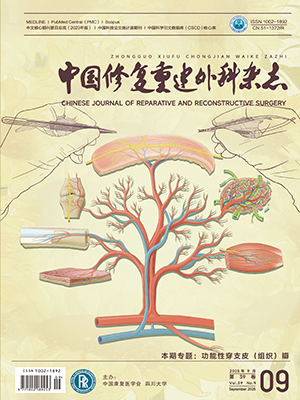Objective To provide the anatomic bases for clinical application of the second dorsal metacarpal artery(SDMA) island flap with double pivot points. Methods The origin,branches and distribution of the recurrent cutaneous branch of the SDMA were observed in 30 adult fresh cadaver specimens, which were illustrated with special dye.Eighteen cases of skin defets of the thumb were repaired with the SDMA island flap. The defect locations were the dorsal part in 11 cases and palmar part in 7 cases, including 3 cases of defect in association with long pollical extensor defect and 2 cases of defect in association with dorsal skin defect of proximal finger. The flap area ranged from 2 cm×3 cmto 3 cm×5 cm. Results The appearance of therecurrent cutaneous branch of the SDMA was observed in all cases(100%), which originated 0.5±0.2 cm distant from the distal intersectiones between the SDMA and the index extensor and disappeared 1.2±0.5 cm distant from the proximal metacarpophalangeal joint. The branches of 1.7±0.7 were seen with a longitudinal fan-like distributionforward proximal part on the deep surface of the dorsal superficial vein. The exradius and the length of the recurrent cutaneous branch of the SDMA were 0.3±0.1 mm and 6.5±0.8 mm, respectively. The transplanted flaps survived in all cases and 16 cases were followed up for 8-14 months. The colour and appearance of the skin were satisfactory. The two-point discriminations were 0.9 mm in 3 cases by bridging digital nerve and 1.1 mm in 9 cases by anastomosing dorsal digital nerve; while the two-point discrimination was 13-15 mm in 4 cases without anastomosing nerve. Conclusion The origin,branches and distribution of the recurrent cutaneous branch of the SDMA is constant, which provide a potentially longer pedicle and increase the possibility to rotate the flap and also avoid the donor skin defect of rotation of the flap.
Citation: YUAN Feng,YU Guangrong,ZHANG Shimin,et al.. APPLIED ANATOMY OF THE SECOND DORSAL METACARPAL ARTERY ISLAND FLAP WITH DOUBLE PIVOT POINTS. Chinese Journal of Reparative and Reconstructive Surgery, 2005, 19(8): 622-625. doi: Copy
Copyright © the editorial department of Chinese Journal of Reparative and Reconstructive Surgery of West China Medical Publisher. All rights reserved




